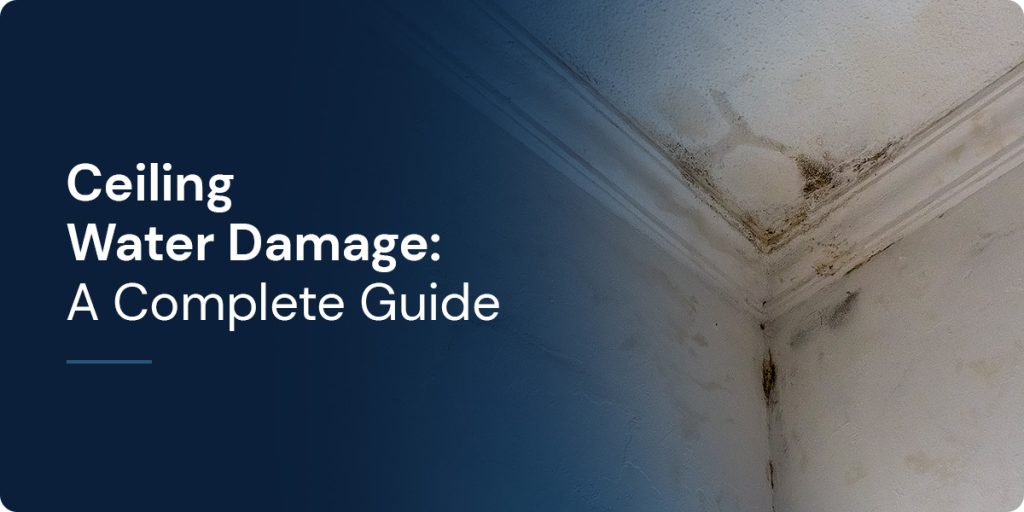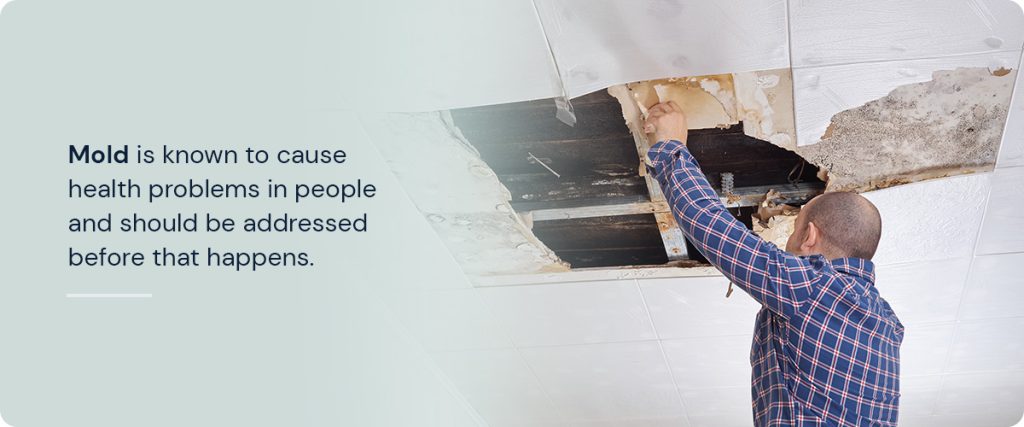
Water damage can become a serious issue for your business quickly. What often starts as a small problem with an easy solution quickly grows into a more serious and damaging situation. This guide will teach you what to look out for so you can more quickly catch a leak and prevent further ceiling water damage. It will also go through what you need to know once you spot a leak and how to repair both the leak and any damage the water has already done to your ceiling.
When your business experiences water damage, ceilings will show some warning signs early, which can prevent more serious damage. Watch out for these indicators to ensure you detect a leak early.
Watch out for watermarks or brown, rusty-looking stains on your ceiling. This is an indication that there is a leak coming from your ceiling. If your business has an attic, it is important to make it a point to periodically inspect the ceiling there for watermarks — a leak would take a while to get through to the ceiling you see every day. This is one of the most common signs of a roof leak.
You may notice the ceiling in your business is bulging or swelling. This can be caused by moisture collecting in the wood and swelling up. The size of the bulge will depend on the severity of the leak. If you catch a small swell, you should get it taken care of as soon as possible to prevent further damage.
Mold often appears in the corners of your ceiling as a sign of water damage. It can appear as quickly as 48 hours after a leak appears if the right amount of humidity is in the air. Mold is more than just an indicator of a leak — it is its own problem that needs to be taken care of quickly. Mold is known to cause health problems in people and should be addressed before that happens.
Moisture condensing on your walls and making them look like they are “sweating” is a sign of a leak that comes before mold or watermarks appear. This is the ideal time to catch a leak because it means minimal damage has been done. It is important to take quick action to keep the problem from escalating.

Maybe you’ve noticed one of the tell-tale signs of ceiling water damage and have no idea what to do next. Here are five simple steps to ensure the issue is resolved as quickly and easily as possible.
Often the source of the leak is not right near the stain or bulge because water has to travel through obstructions before making its way to the ceiling. However, if your ceiling is right up against the attic, you may be able to identify the source of the leak based on where the visual cue.
If the water is actively leaking, you can follow the sound of the dripping. If it is not actively leaking, you will need to find the source based on the location of the damage.
If you find the source is a pipe with running water, the best solution is to turn off the water source that is sending water through that pipe. If the source is from a crack in the roof, you may need to stick to preventive measures to contain the leaking water until you can get the crack patched. Be sure to move any valuables near the leak out of the way and place buckets underneath it. Don’t forget to switch out these buckets if necessary.
Before you begin repairing, you can also drain the leak to get as much water as you can out that has already accumulated. Do this by pushing a screwdriver into the location of the leak and away from the framing boards. This should help prevent further damage.
If the water is coming through a leak in your business’ attic, you can patch it with some sort of durable material like wood or spare shingling. Securing the material with roofing tar will help secure the patch. These patches are not solutions, and you will eventually need to hire a roofing professional to conduct ceiling water damage repairs once and for all.
If the leak results from excessive rain and your roof simply does not hold up to the weather, you may need a full roof replacement. At the least, a roofing professional needs to come to repair all of the individual leaks. In the meantime, contain the water coming through your ceiling and do what you can to keep it from getting on the floor or other valuables.
If you moved a piece of furniture out of the way while repairing a roof leak, it is important to make sure valuables and the floor are completely dry before putting things back to the way they were. Use fans and natural air if you can to dry out the affected area. Adding a fan will speed up the drying process and keep the water from seeping into the floor, further damaging it.
Though you’ve now stopped the leak, there is still damage to your ceiling. You will likely need to hire a professional to handle replacing or repairing ceiling damage and get it back up to code. They will be able to make sure it is structurally secure and still has the proper insulation.
Unlimited Restoration provides your commercial or industrial business with comprehensive water damage restoration services. We will do our best to make sure you are well prepared for whatever comes your way, and we will be there should something happen to your business.
If you experience a roof leak, Unlimited Restoration can provide roof leak repairs using our over 25 years of experience.
Contact Unlimited Restoration today to find out how we can help you be prepared for whatever comes your business’ way and how we can provide solutions after an event. If you need emergency assistance immediately, call our Emergency Response Hotline at 888-327-9664.
